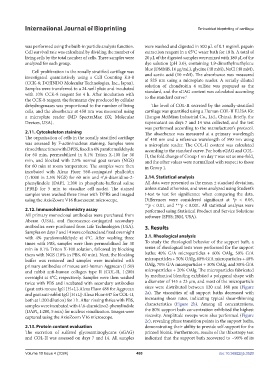Page 488 - IJB-10-4
P. 488
International Journal of Bioprinting Embedded bioprinting of cartilage
was performed using the built-in particle analysis function. were washed and digested in 500 µL of 0.1 mg/mL papain
Cell survival rate was calculated by dividing the number of extraction reagent in a 65°C water bath for 18 h. A total of
living cells by the total number of cells. Three samples were 20 µL of the digested samples were mixed with 180 µL of the
analyzed for each group. dye solution (pH 3.0), containing 1,9-dimethylmethylene
Cell proliferation in the zonally stratified cartilage was blue (DMMB, 16 μg/mL), glycine (40 mM), NaCl (40 mM),
investigated quantitatively using a Cell Counting Kit-8 and acetic acid (10 mM). The absorbance was measured
(CCK-8; DOJINDO Molecular Technologies, Inc., Japan). at 525 nm using a microplate reader. A serially diluted
Samples were transferred to a 24-well plate and incubated solution of chondroitin 4 sulfate was prepared as the
with 10% CCK-8 reagent for 4 h. After incubation with standard, and the sGAG content was calculated according
to the standard curve.
6
the CCK-8 reagent, the formazan dye produced by cellular
dehydrogenases was proportional to the number of living The level of COL-II secreted by the zonally-stratified
cells, and the absorbance at 450 nm was measured using cartilage was quantified using a Human COL-II ELISA Kit
a microplate reader (MD SpectraMax i3X; Molecular (Jiangsu MeiMian Industrial Co., Ltd., China). Briefly, the
Devices, USA). supernatant on days 7 and 14 was collected, and the test
was performed according to the manufacturer’s protocol.
2.11. Cytoskeleton staining The absorbance was measured at a primary wavelength
The organization of cells in the zonally stratified cartilage of 450 nm and a reference wavelength of 590 nm using
was assessed by F-actin/nucleus staining. Samples were a microplate reader. The COL-II content was calculated
rinsed three times with DPBS, fixed in 4% paraformaldehyde according to the standard curve. For both sGAG and COL-
for 60 min, permeabilized in 0.1% Triton X-100 for 30 II, the fold change of Group 1 on day 7 was set as one-fold,
min, and blocked with 2.5% normal goat serum (NGS) and the other values were normalized with respect to those
for 60 min at room temperature. The samples were then in Group 1.
incubated with Alexa Fluor 568-conjugated phalloidin
(1:1000 in 2.5% NGS) for 60 min and 4ʹ,6-diamidino-2- 2.14. Statistical analysis
phenylindole (DAPI, 1:200 in phosphate-buffered saline All data were presented as the mean ± standard deviation,
[PBS]) for 5 min to visualize cell nuclei. The stained unless stated otherwise, and were analyzed using Student’s
samples were washed three times with DPBS and imaged t-test to test for significance when comparing the data.
using the AxioZoom V16 fluorescent microscope. Differences were considered significant at *p < 0.05,
**p < 0.01, and ***p < 0.001. All statistical analyses were
2.12. Immunohistochemistry assay performed using Statistical Product and Service Solutions
All primary monoclonal antibodies were purchased from software (SPSS; IBM, USA).
Abcam (USA), and fluorescence-conjugated secondary
antibodies were purchased from Life Technologies (USA). 3. Results
Samples on days 7 and 14 were collected and fixed overnight
with 4% paraformaldehyde at 4°C. After washing three 3.1. Rheological analysis
times with PBS, samples were then permeabilized for 30 To study the rheological behavior of the support bath, a
min in 0.1% Triton X-100 solution, followed by blocking series of rheological tests were performed for the support
them with NGS (10% in PBS, 60 min). Next, the blocking baths: 40% G/A microparticles + 60% OAlg, 50% G/A
buffer was removed and samples were incubated with microparticles + 50% OAlg, 60% G/A microparticles + 40%
primary antibodies of mouse anti-human Aggrecan (1:50) OAlg, 70% G/A microparticles + 30% OAlg, and 80% G/A
and rabbit anti-human collagen type II (COL-II, 1:200) microparticles + 20% OAlg. The microparticles fabricated
overnight at 4°C, respectively. Samples were then washed by mechanical blending exhibited a polygonal shape with
twice with PBS and incubated with secondary antibodies a diameter of 145 ± 23 μm, and most of the microparticle
(goat anti-mouse IgG [H+L]-Alexa Fluor 488 for Aggrecan sizes were distributed between 120 and 160 μm (Figure
and goat anti-rabbit IgG [H+L]-Alexa Fluor 647 for COL-II, 2a). The viscosities of all support baths decreased with
both at 1:200 dilution) for 1 h. After rinsing thrice with PBS, increasing shear rates, indicating typical shear-thinning
samples were incubated with 4ʹ,6-diamidino2-phenylindole characteristics (Figure 2b). Among all concentrations,
(DAPI, 1:200, 5 min) for nucleus visualization. Images were the 80% support bath concentration exhibited the highest
captured using the AxioZoom V16 microscope. viscosity. Amplitude sweeps were also performed (Figure
2c), revealing phase transition points in the support baths,
2.13. Protein content evaluation demonstrating their ability to provide self-support for the
The excretion of sulfated glycosaminoglycans (sGAG) printed bioink. Furthermore, results of the thixotropy test
and COL-II was assessed on days 7 and 14. All samples indicated that the support bath recovered to ~90% of its
Volume 10 Issue 4 (2024) 480 doi: 10.36922/ijb.3520

